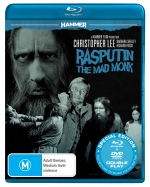Rasputin: The Mad Monk (Blu-ray) (1966) |
|
Rasputin: The Mad Monk (Blu-ray) (1966) |
|


|
| BUY IT |
| General | Extras | ||
| Category | Horror |
Alternative Version-Rasputin The Mad Monk 2.55:1 version Audio Commentary-Cast Featurette-Making Of-Tall Stories (24:24) Featurette-Brought to Book: Hammer Novelisations (14:35) Gallery-(3:14) Trailer-Hammer Trailers including Rasputin: The Mad Monk |
|
| Rating |

|
||
| Year Of Production | 1966 | ||
| Running Time | 92:00 | ||
| RSDL / Flipper | Dual Layered | Cast & Crew | |
| Start Up | Menu | ||
| Region Coding | 2,4 | Directed By | Don Sharp |
|
Studio
Distributor |
Seven Arts Shock Entertainment |
Starring |
Christopher Lee Barbara Shelley Richard Pasco Francis Matthews Suzan Farmer Dinsdale Landen Renée Asherson Derek Francis Joss Ackland Robert Duncan Alan Tilvern John Welsh John Bailey |
| Case | ? | ||
| RPI | $19.95 | Music | Don Banks |
| Video | Audio | ||
| Pan & Scan/Full Frame | None | English Dolby Digital 1.0 (448Kb/s) | |
| Widescreen Aspect Ratio | 2.35:1 | ||
| 16x9 Enhancement |
 |
||
| Video Format | 1080p | ||
| Original Aspect Ratio | 2.35:1 | Miscellaneous | |
| Jacket Pictures | No | ||
| Subtitles | English for the Hearing Impaired | Smoking | Yes |
| Annoying Product Placement | No | ||
| Action In or After Credits | No | ||
In Rasputin: The Mad Monk we first see the uncouth peasant monk Rasputin (Christopher Lee) cure the wife of an innkeeper by using his hands to draw the sickness from her body. He then gets drunk at the inn and attempts to rape the innkeeper’s daughter. This is Rasputin in a couple of scenes; a healer, a drunk and a womaniser.
Rasputin then travels to St Petersburg. In a tavern he outdrinks Boris (Richard Pasco), a struck off doctor, when a group from the Russian court consisting of Ivan (Francis Matthews), his sister Vanessa (Suzan Farmer), Peter (Dinsdale Landen) and his sister Sonia (Barbara Shelley), arrive. Sonia is mesmerised, hypnotised and later seduced by Rasputin, becoming his mistress, and through her Rasputin gains access to the Tsarina (Renee Asherson) and her son. Rasputin hypnotises the Tsarina, gaining wealth and fame, but along the way he discards those, like Sonia, who are no longer of use. But Rasputin has made enemies who are determined that he must be killed.
In the 1960s historical epics were a popular art form; think Lawrence of Arabia (1962), Cleopatra (1963), Doctor Zhivago (1965) or any number of films starring Charlton Heston. With Rasputin: The Mad Monk Hammer had a go at a historical epic of their own, delving into history and real people for one of the few times they did. Hammer did pull out all the stops; Rasputin: The Mad Monk was shot in glorious widescreen Cinemascope, the sets are large, set direction detailed, the costumes lavish, the music by Don Banks swells and there is a larger than life performance by Christopher Lee. Other characters played by Lee, such as Count Dracula, required a controlled performance but Rasputin with his long hair, wild beard and piercing eyes allows Lee an opportunity to be boisterous, loud, energetic and mesmerising, an opportunity he takes with both hands to deliver a wonderful over the top but still nuanced performance. This is Lee at his best as he owns the character totally. The scene where he is visited by a foppish Matthews is great, amusing for what is not said and the expressions on the face of both actors.
Indeed, Rasputin: The Mad Monk was shot at Bray Studios back to back with Dracula: Prince of Darkness and featured many of the same cast, Lee, Francis Matthews, Suzan Farmer and Barbara Shelley, although with a different director, Don Sharp. Tasmanian born Sharp had directed his first Hammer film in 1963 (The Kiss of the Vampire) and went on to direct Lee in six films, including The Brides of Fu Manchu made in the same year as Rasputin: The Mad Monk. Sharp is at home with the epic aspects of the story but he also shows a firm grip on the tense and horror sequences, such as when Peter comes to kill Rasputin, a sequence replete with darkness, shadows and briefly lit faces in a sea of black.
Rasputin: The Mad Monk was released by Hammer with the disclaimer "this is an entertainment, not a documentary. No attempt has been made at historical accuracy... all the characters and incidents may be regarded as fictitious." Although this disclaimer was for legal reasons, it is fair to say that Rasputin: The Mad Monk is more salacious myth than history; as is discussed in the making of extra on this Blu-ray, Rasputin was neither mad nor a monk, while the published version of his death, based upon the book written by one of his aristocratic killers years later, was a fabrication. So history Rasputin: The Mad Monk may not be but fabulous entertainment it certainly is, and it remains so 50 years after being made.
Rasputin: The Mad Monk is presented in the original 2.35:1 aspect ratio, in 1080p, MPEG-4 AVC code.
In a word: gorgeous! Shot in Cinemascope on film, detail is astounding. The lavish sets and costumes are beautiful, the close-ups show in fine detail every hair in Lee’s unkempt beard and hair, every wrinkle or bead of sweat on his face, his mesmerising eyes and gnarled hands. The colours, whether exteriors or interiors, are deep and vibrant, including Rasputin’s red satin costume. Blacks are solid and shadow detail very good. Grain is nicely controlled; I saw no marks or artefacts.
English subtitles for the hearing impaired are available in a clear white font.
| Sharpness | |
| Shadow Detail | |
| Colour | |
| Grain/Pixelization | |
| Film-To-Video Artefacts | |
| Film Artefacts | |
| Overall |
Audio is an English Dolby Digital 1.0 mono at 448 Kbps; the film was shown theatrically with mono sound.
Despite being a lossy track, dialogue is always easy to understand with Lee’s unique voice clear. While this is a mono audio, effects such footsteps and carriage wheels are crisp. The epic score by Don Banks avoids clichéd Russian cues and is perfect for the film.
There is obviously no surround or subwoofer use.
I did notice slight hiss occasionally.
Lip synchronisation looked fine.
| Dialogue | |
| Audio Sync | |
| Clicks/Pops/Dropouts | |
| Surround Channel Use | |
| Subwoofer | |
| Overall |
A screen text appears before this version of the film which pretty much explains everything:
“Rasputin: The Mad Monk was shot in 4-perf CinemaScope with anamorphic lenses, “squeezing” a 2.55:1 picture into a standard 35mm (1.37:1) frame. The film was always intended to be matted down to 2.35:1 and this was achieved by losing detail at the left (more) and right (less) of the picture. We have restored the film 'open gate' at its entire shooting ratio, so that we can show more of the picture as filmed. Although the film was never intended to be screened at the 2.55:1 aspect ratio, this version serves as a fascinating insight into both the composition of the original frame by cinematographer Michael Reed, and the overall production design (by Bernard Robinson) of Don Sharp's film, as often an almost perfectly symmetrically composition emerges when seen at 2.55:1, which is absent from the 2.35:1 matted version. The anamorphic lenses used create a concave effect at the extreme left and right of the picture, which is sometimes clearly visible in the 2.55:1 version. The credit sequence of the 2.55:1 version has a vertical space at the left-edge, the credits being created within the 2.35:1 frame.”
This version is technically the same; 1080p using MPEG-4 AVC code, Dolby Digital 1.0, English subtitles.
Cast members Christopher Lee, Suzan Farmer, Francis Matthews and Barbara Shelley sit together and watch the film. This is entertaining and amusing as they chat, sometimes cutting across each other, about their memories of the filming, the cast and crew, the set direction, cut scenes and Hammer. Lee has read about Rasputin a lot and is very knowledgeable about the real events and the myths surrounding Rasputin’s murder. He also talks about meeting the killers of Rasputin when he was about 9.
Made in 2012 this is a fascinating featurette using film footage, still photographs and recent interviews with authors Jonathan Rigby (Christopher Lee: The Authorised Screen History), Denis Meikle (A History of Horror), David Huckvale (Hammer Film Scores and the Musical Avant-Garde) and Andrew Cook (To Kill Rasputin), plus original cast members Barbara Shelley and Francis Matthews. Cook argues, based upon recent discoveries including Rasputin’s autopsy records and autopsy photographs (some of which are shown), that Rasputin was neither mad nor a monk, that the accounts of his murder are myth and that he was most likely killed with the assistance, or contrivance, of British intelligence! Other things discussed include the genesis of the film, the cast, including Christopher Lee, the score and scenes that were cut to reduce the running time, including a major fight between Lee (or more precisely his double) and Matthews, who is still not happy about it!
Author Jonathan Rigby (Studies in Terror: Landmarks of Horror Cinema), author and publisher Johnny Main and writer and actor Mark Gatiss provide an interesting insight into the history of the tie ins between Hammer films and their novelisations by various publishers and writers including John Burke; pulp fiction in a period before video allowed people to revisit the films themselves.
Approximately 60 black and white and colour posters, film promotions, film stills and on set photographs. They advance automatically, with music and film dialogue.
There is censorship information available for this title. Click here to read it (a new window will open). WARNING: Often these entries contain MAJOR plot spoilers.
NOTE: To view non-R4 releases, your equipment needs to be multi-zone compatible and usually also NTSC compatible.
There is no Region A US Blu-ray of Rasputin: The Mad Monk. Our release is the same as the Region B UK although that uses a LPCM 1.0 audio and adds a World of Hammer short on Costumers.
It is probably true to say that they don’t make them like Rasputin: The Mad Monk any more, which is a pity. Hammer did not do many historical epics and Rasputin: The Mad Monk may not be very good history but, with lavish sets and costumes, a swelling and dramatic score by Don Banks and Christopher Lee in a role he was born to play, it remains wonderful entertainment fifty years after it was made.
The film looks splendiferous on Blu-ray, the audio is the original mono. The extras are excellent.
Rasputin: The Mad Monk is available as a stand-alone Blu-ray / DVD release from Shock Entertainment but it is also included in Shock’s 17 disc Hammer Horror Blu-ray Collection, which also adds two DVDs of World of Hammer shorts, including the one on “Costumers” included in the UK Blu-ray release. The specifications and extras on both releases are the same, though without the DVD of course.
| Video | |
| Audio | |
| Extras | |
| Plot | |
| Overall |
| Review Equipment | |
| DVD | Sony BDP-S580, using HDMI output |
| Display | LG 55inch HD LCD. This display device has not been calibrated. This display device is 16x9 capable. This display device has a maximum native resolution of 1080p. |
| Audio Decoder | NAD T737. This audio decoder/receiver has not been calibrated. |
| Amplification | NAD T737 |
| Speakers | Studio Acoustics 5.1 |